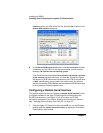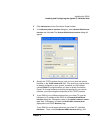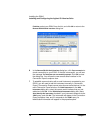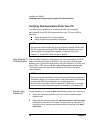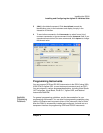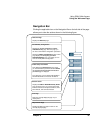
74 Chapter 2
Installing the E5810
Installing and Configuring the Agilent IO Libraries Suite
For information on programming using Agilent VISA, see the Agilent VISA
User’s Guide. Also see the Agilent Connectivity Guide and Agilent
IO Libraries Suite Online Help for further information and guidelines on
programming with the Agilent IO Libraries.
Addressing
Instruments using
VISA and Remote
IO Client
Once you have created a remote GPIB or remote serial interface in
Connection Expert, you can use ordinary GPIB or serial addressing in your
VISA or VISA COM programs to address instruments on these interfaces.
The Remote IO Client software maps TCPIP address requests into
appropriate interface type (GPIB or ASRL) addresses; thus the IP address
and hostname of the E5810 do not appear in the instrument address. This
makes it possible to use existing programs written for GPIB or ASRL without
having to modify code.
See “Configuring a Remote GPIB Interface” on page 66 or “Configuring a
Remote Serial Interface” on page 68 to configure a remote GPIB or remote
serial interface. VISA programs can then use addresses such as
GPIB0::22::INSTR (for GPIB) or ASRL1::INSTR (for RS-232). Use
these addresses in your viOpen() call as follows:
viOpen (...”GPIB0::22::INSTR”...)
viOpen (...”ASRL1::INSTR”...)
Addressing
Instruments using
VISA and TCPIP
Interface
Although remote GPIB and remote serial interfaces are the most convenient
way to configure and program instruments on your E5810, you may choose
not to use them. For example, if you are using another vendor’s I/O software
rather than the Agilent IO Libraries Suite, your I/O software probably does
not support remote interface addressing. (At the time of this writing, only
Agilent software supports remote interface types.)
If you are not using remote interfaces, you will address your instruments as
TCPIP resources in VISA. These addresses include the IP address or
hostname of the E5810 as well as the SICL address of the device on the
E5810.
Use these addresses in your viOpen() call as follows. These examples
assume that the VISA interface ID of your TCPIP interface is “TCPIP0”. (You
can specify this interface ID with the Connection Expert utility; “TCPIP0” is
the default VISA ID for the default TCPIP interface.)
viOpen (...”TCPIP0::my_IP_address::gpib0,22::INSTR”...)
viOpen (...”TCPIP0::my_IP_address::COM1,488::INSTR”...)





